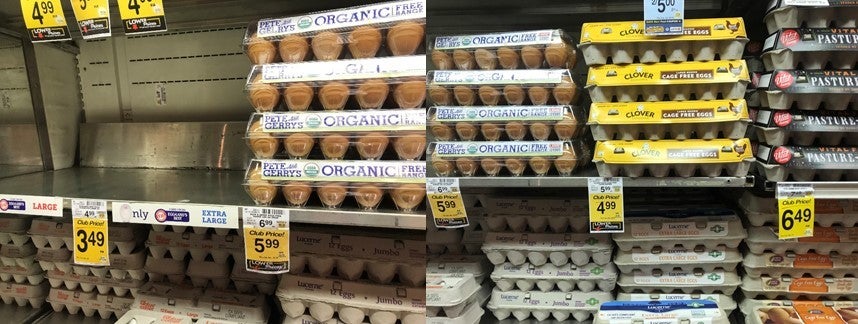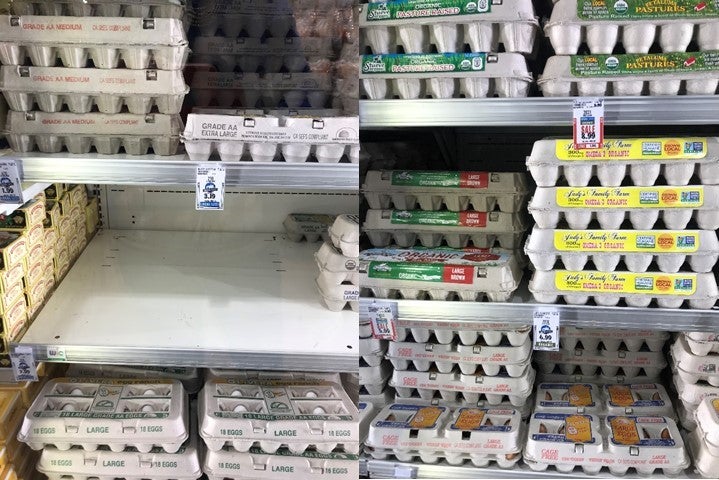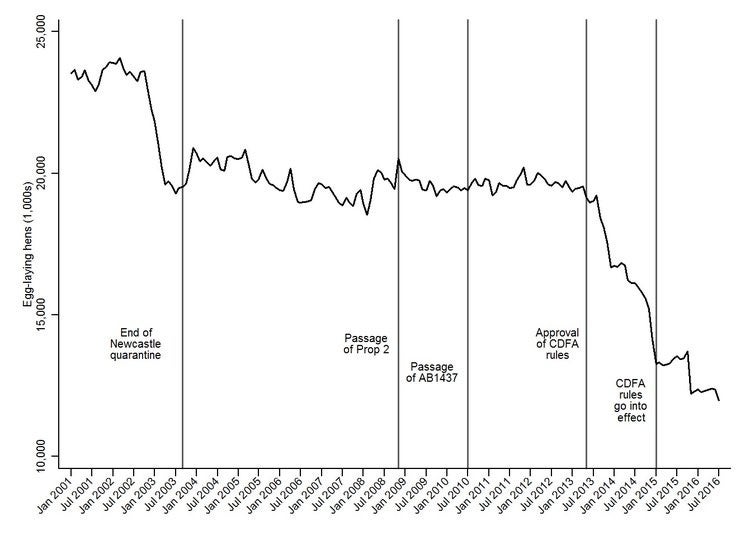On a trip to my local grocery story on Christmas Eve, I was struck by a phenomena in the egg case. There were plenty of choices available to shoppers, and this picture says a thousand words. Shoppers purchased the least expensive eggs. They had the choice of more expensive cage-free, organic and pasture-raised eggs, but at this grocery store in the fairly wealthy town of Davis, when given the choice, the less expensive eggs.

And just so I don’t get accused of cherry picking my data I went to the more exclusive specialty grocery store in town, (because they have the best goat’s cheese), and there I saw a similar phenomenon. I do realize that this is now only an N of two!
 The $2.99/ dozen large eggs outsold the other choices including the $6.99/dozen enhanced omega-3 eggs and the $8.99/dozen pasture-raised eggs. If you look carefully you will see all of these eggs say they are CA SEFS Compliant (California Shell Egg Food Safety Compliant). What does this actually mean?
The $2.99/ dozen large eggs outsold the other choices including the $6.99/dozen enhanced omega-3 eggs and the $8.99/dozen pasture-raised eggs. If you look carefully you will see all of these eggs say they are CA SEFS Compliant (California Shell Egg Food Safety Compliant). What does this actually mean?
Almost a decade ago, in 2008, California voters passed Proposition 2. The proposition, sponsored by Humane Society of the United States (HSUS), required that egg-laying hens (and calves raised for veal and pregnant pigs) be confined only in ways that “allow these animals to lie down, stand up, fully extend their limbs and turn around freely”. Given we don’t raise many calves for veal or pigs in California – the full impact of the initiative was mostly felt by the egg-layer industry. The full implementation of the law took effect January 1, 2015.
The vagueness of the language in this proposition was challenged by some egg producers. One company, JS West built two new barns in the style of those found in Europe called enriched colony (EC) cages where the chickens have almost twice as much space, as well as perching, nesting, and scratching area. According to Modern Farmer,
“The construction cost $7.2 million, and the eggs, sold under the name “Comfort Coop,” are sometimes marked up by grocery stores as high as a dollar over conventional eggs. When that’s the case, [Senior Vice President Jill Benson] says, “The sales are drastically reduced.” So much for giving voters what they want.”
Finally on May 6, 2013, the California Department of Food and Agriculture issued regulations stipulating the minimum number of square inches of floor space per laying hen that shall be deemed to constitute compliance with Prop 2, i.e. CA SEFS Compliant. The regulations say, in part: “An enclosure containing nine or more egg-laying hens shall provide a minimum of 116 square inches of floor space per bird.” And that is the standard CA SEFS Compliant eggs have been adhering to since January 1, 2015.
When Californians were debating Proposition 2, proponents assured consumers that the price of eggs would increase only a little, if at all. However, the University of California Agricultural Issues Center (AIC), attached to UC-Davis, issued a July 2008 study about the fiscal impact. That study said: “The best evidence from a variety of sources suggests that (non-organic) non-cage systems incur costs of production that are at least 20 percent higher than the common cage housing systems. This is due to higher feed costs, higher hen laying mortality, higher direct housing costs, and higher labor costs. The study also estimated that the California egg industry would relocate to other states during the 5-year adjustment period. The study concluded that the cost to consumers of the cheapest California-produced eggs would increase by at least 25%.”
Proponents of Proposition 2 suggested that the additional cost would amount to only about a penny an egg, or 12 cents per dozen.
So what actually happened? According to USDA NASS statistics the number of eggs produced in CA from 2008 to 2016 dropped ~34% from 5.271 billion eggs to 3.474 billion eggs.
 This decrease in egg production was accompanied by a decline of egg-laying hens in California. A 2014 Washington Post BLOG estimated the loss of 10 million egg laying chickens in CA, a prediction that was pretty accurate as evidenced by this graphic posted on Jason Lusk’s BLOG
This decrease in egg production was accompanied by a decline of egg-laying hens in California. A 2014 Washington Post BLOG estimated the loss of 10 million egg laying chickens in CA, a prediction that was pretty accurate as evidenced by this graphic posted on Jason Lusk’s BLOG
 The egg prices have bounced around a little. The USDA Market News Service reported that California wholesale egg prices for the small benchmark egg increased 24 percent, from $1.13 a dozen on Jan. 16, 2014, to $1.40 on Jan. 2, 2015, when Proposition 2 went into effect. According to Jason Lusk’s BLOG “We find that the average price paid per dozen eggs was about 22% higher from December 2014 through September 2016 than it would have been in the absence of the hen housing restrictions. The price impact fell over time, from an initial impact of about 33% per dozen to about 9% over the last six months of the observed time horizon.” That number is pretty close to the 25% predicted by the University of California AIC.
The egg prices have bounced around a little. The USDA Market News Service reported that California wholesale egg prices for the small benchmark egg increased 24 percent, from $1.13 a dozen on Jan. 16, 2014, to $1.40 on Jan. 2, 2015, when Proposition 2 went into effect. According to Jason Lusk’s BLOG “We find that the average price paid per dozen eggs was about 22% higher from December 2014 through September 2016 than it would have been in the absence of the hen housing restrictions. The price impact fell over time, from an initial impact of about 33% per dozen to about 9% over the last six months of the observed time horizon.” That number is pretty close to the 25% predicted by the University of California AIC.
And for their efforts in trying to give objective evidence-based estimates to the California public voting on this initiative in 2008, HSUS sued the UC Davis AIC alleging that their cost study characterized Proposition 2 “as having a negative economic effect on California citizens”. They claimed in the state voter’s pamphlet that anyone who said egg prices would increase as a result of its passage was using “scare tactics.”
According to Lusk “These [egg] price increases correspond to welfare losses of at least $117 million for the three California markets [in LA, San Diego, and San Francisco from December 2014 to September 2016]. Our results suggest annual average welfare losses of at least $2 per California household in future years.” Lusk is obviously referring to human welfare in this case.
He also has a very “economicy” peer-reviewed paper looking at this which concludes Californians now pay between $0.48 and $1.08 more for a dozen eggs as a result of Proposition 2. The estimates suggest an annual reduction in California consumer surplus of between $400 million and $850 million. This cost increase is important as eggs provide a nutritious staple food used disproportionately by low-income families. California has the dubious honor of being home to the nation’s highest (20.6) percent poverty rate when considering the U.S. Census Bureau’s Supplemental Poverty Measure which takes into account the cost of living.
So what have been the actual impacts of Proposition 2? There are many less egg-laying chickens and eggs being produced in California, the state is importing more eggs to make up the shortfall, the cost of eggs has gone up around 25%, the choice to purchase eggs from hens in conventional cages is no longer an option for the 39.25 million California consumers, and California consumers are spending between $400 million and $850 million more on eggs. Pretty much exactly what the AIC study predicted. And has the welfare of chickens actually improved? More on that in my next BLOG.